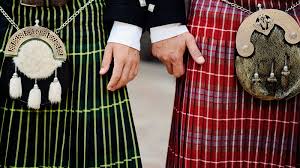The kilt is a powerful symbol of Scottish heritage, embodying centuries of tradition, pride, and cultural identity. Whether you’re of Scottish descent or simply an admirer of this iconic garment, understanding the nuances of wearing a kilt can enhance your connection to its rich history. From its origins as the practical “féileadh mór” to its evolution into the refined attire we recognize today, the kilt has been a staple of Scottish dress for generations. For men wearing kilts, the experience is about more than just the look—it’s about embracing a piece of history and wearing it with pride. This guide will walk you through everything you need to know, from selecting the right type of kilt for various occasions to mastering the proper way to wear one. Whether you’re preparing for a formal event or simply want to incorporate this timeless piece into your wardrobe, wearing a kilt allows you to participate in a tradition that celebrates resilience, individuality, and a deep connection to Scottish culture.
The History of the Kilt
The kilt’s history is deeply entwined with the cultural identity of Scotland. The earliest forms of the kilt, known as the “féileadh mór” or “great kilt,” emerged in the 16th century. This garment was essentially a long piece of woolen cloth, about 5 to 7 yards in length, which was wrapped around the body and belted at the waist, leaving the remaining fabric draped over the shoulder. The great kilt was highly practical for the Highlanders, offering protection from the elements and flexibility in how it was worn. The upper part could be used as a cloak, a blanket for sleeping, or even a makeshift tent. As time went on, the kilt evolved into the more familiar “féileadh beag” or “small kilt” that we recognize today. By the 18th century, this version had become popular, characterized by its pleated skirt that stopped at the knees, making it easier to wear and move in.
Types of Kilts
When it comes to kilts, there’s a variety to choose from, each serving different purposes and catering to different tastes. The main types include:
- Traditional Kilts: These are the most iconic and are typically made from about 8 yards of woolen fabric. They are pleated at the back, with a flat front, and are usually worn with a sporran, a kilt belt, and other traditional accessories. Traditional kilts are often associated with formal occasions and are usually made in a clan tartan, representing a specific Scottish family or region.
- Modern Kilts: Modern kilts are an adaptation of the traditional kilt, designed for versatility and everyday wear. These can include tactical kilts, utility kilts, and hybrid kilts. Modern kilts often feature practical additions like pockets, lighter materials, and simpler designs, making them suitable for casual wear and activities such as hiking or festivals.
- Tartan Kilts: These kilts are made from a specific tartan pattern, which is a crisscross design of horizontal and vertical bands in multiple colors. Each tartan is associated with a particular clan, region, or institution. Tartan kilts are the most traditional form of kilts and are often worn during formal events or ceremonies.
How to Wear a Kilt Properly
Wearing a kilt properly involves more than just wrapping it around your waist. Here’s a step-by-step guide to ensure you wear it with style and respect:
- Length & Fit: The kilt should sit high on your waist, typically at the navel. The hem should fall at the middle of the knee, covering your kneecap when you’re standing. The fit is crucial; it should be snug enough to stay in place but not so tight that it restricts movement.
- Pleats: The pleats of the kilt should be positioned at the back. Traditional kilts usually have between 20 to 29 pleats, which can be either “knife pleats” (all pleats folded in the same direction) or “box pleats” (alternating pleats folded towards each other).
- Kilt Belt & Sporran: The kilt belt is typically wide, made of leather, and worn through belt loops at the back of the kilt. The sporran, a pouch that hangs at the front, serves both practical and decorative purposes. It should hang about 3 to 4 inches below the belt buckle and is often chosen to match the formality of the event.
- Kilt Hose & Flashes: Kilt hose are the long socks worn with a kilt, usually in a color that complements the tartan. They should be pulled up to just below the knee. Flashes, which are small strips of fabric that match the kilt, are worn with garters to keep the hose in place.
- Ghillie Brogues: These are traditional Scottish shoes designed to be worn with kilts. They are characterized by their long laces, which are tied around the ankle. Ghillie brogues are a must for formal occasions but can be replaced with other shoes for casual wear.
- Jacket & Waistcoat: For formal occasions, a Prince Charlie jacket and waistcoat are often worn with a kilt. The jacket is short and cut high to accommodate the kilt, while the waistcoat provides a smart, layered look. For less formal occasions, a tweed jacket or Argyll jacket might be worn instead.
Occasions for Wearing a Kilt
Kilts can be worn for a variety of occasions, ranging from highly formal events to more casual settings. Understanding the appropriate context for wearing a kilt will help you choose the right style and accessories.
- Formal Events: Weddings, graduations, and formal dinners are classic occasions for wearing a kilt. For such events, a full Highland dress is appropriate, including a Prince Charlie jacket, waistcoat, sporran, and all the accessories. The tartan chosen often reflects the wearer’s clan or personal heritage.
- Highland Games & Cultural Festivals: The Highland Games, Burns Night, and other cultural festivals are prime occasions for wearing a kilt. While these events are traditional, the atmosphere is often more relaxed, allowing for a variety of kilt styles, from traditional to modern. Wearing a kilt at these events is a way to show pride in Scottish culture and connect with others who share the same heritage.
- Military & Ceremonial: Kilts are still worn in certain Scottish regiments of the British Army, particularly during ceremonial duties. The regimental tartan and the way the kilt is worn in these contexts are strictly regulated, reflecting the deep-rooted traditions of the military.
- Casual Wear: Modern kilts, such as utility kilts, are increasingly being worn as part of everyday casual attire. These kilts are often made from lighter materials and designed with practical features like pockets, making them suitable for a variety of activities, from hiking to attending music festivals.
Buying the Perfect Kilt:
When looking to purchase a kilt, it’s essential to find one that not only fits well but also reflects your personal style and cultural heritage. Whether you’re seeking a traditional tartan kilt for a formal event or a modern utility kilt for casual wear, choosing the right one involves considering factors such as fabric quality, pleat style, and appropriate accessories. Online retailers offer a wide range of kilts, allowing you to customize your selection based on your preferences. Investing in a well-crafted kilt ensures you acquire a garment that is both stylish and timeless, suitable for various occasions.
Caring for Your Kilt
Investing in a kilt means you’ll want to take good care of it to ensure it lasts for years. Here are some tips on how to maintain your kilt:
- Cleaning: Most traditional kilts are made of wool and should be dry cleaned to prevent shrinkage and damage. Modern kilts, depending on the material, might be machine washable, but it’s always best to check the care instructions provided by the manufacturer.
- Storing: Store your kilt in a cool, dry place, ideally hung on a kilt hanger to maintain its shape. Avoid folding your kilt for long periods, as this can cause creases that are difficult to remove.
- Ironing: If your kilt becomes wrinkled, use a steam iron on a wool setting to gently press it. Always iron on the reverse side of the fabric and avoid applying direct heat to the pleats, as this can cause them to lose their sharpness.
- Repairs: Regularly check your kilt for any loose threads or small tears. These should be repaired promptly to prevent further damage. For more significant repairs, consider taking your kilt to a professional kiltmaker or tailor who specializes in Highland wear.
Conclusion
Wearing a kilt is more than just adopting a fashion statement; it’s embracing a rich cultural heritage that spans centuries. Whether you’re wearing a traditional tartan kilt for a formal event or a modern utility kilt for a casual day out, understanding the history, significance, and proper etiquette of kilt-wearing will enhance your experience. The kilt is a versatile garment that has evolved over time, yet it remains deeply rooted in the identity of Scotland. By donning a kilt, you’re not only paying homage to Scottish culture but also participating in a tradition that celebrates pride, resilience, and individuality. So, whether you’re attending a wedding, competing in the Highland Games, or simply exploring your cultural roots, wear your kilt with confidence, and let it tell your story.
More Read About baddiehub




